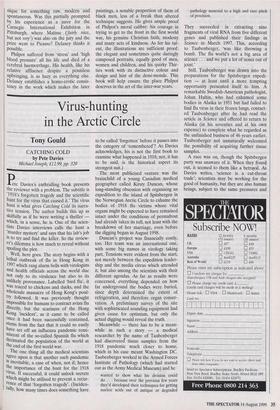What went on in the closet
John McEwen
GLYN PHILPOT by J. G. P. Delaney Ashgate, £39.95, pp. 179 Delaney's previous biography was of the Edwardian painter, Charles Ricketts. Now he has written one of Glyn Philpot (1884-1937), a younger artist, who knew and was influenced by Ricketts and was equally quirky in his 'gay' and aesthetic way.
The recent death of Gabrielle Cross, the artist's niece and owner of his estate, has released a significant number of Philpot's Fugue, 1931-2 pictures and sculptures on to the market, and this biography is well timed to meet the current renewal of interest.
Delaney is a professor of English litera- ture and brings an academic thoroughness to his task. He concentrates particularly on Philpot's 'character', in other words his pri- vate life, until now something of a mystery; and so, unfortunately, it remains. Philpot's gentlemanly reserve and self-deprecation — 'he never took himself over-seriously'- mean that his life uninformatively survives uninformatively largely through bland cor- respondence, generalised reminiscence and good reviews. Part of the renewed interest in Philpot is due to his homosexuality. The big question is not so much why he did not come out of the closet as what went on inside. He lived in a repressive era of 'queers' and 'pansies'. Sickert mused: 'A pansy in my time was a flower.'
A strict Baptist upbringing only intensi- fied Philpot's guilt. His mother died when he was seven, to be succeeded by a much loved stepmother, who did not even ride a bicycle for fear of offending the Lord. The children learned to lead a double life to have any fun. At 22 he boldly converted to Catholicism, which, as regards sexual guilt, was a case of out of the frying pan and into the fire.
Delaney minutely sifts the material, but, as his prime source is the self-censored cor- respondence Philpot had with his innocent older sister Daisy (even she never knew his dark secret), the rewards are few. Philpot became famous in England as a society portraitist and moved accordingly in quite exotic circles; but only Siegfried Sassoon has anything much to say about him: `Philpot just misses being first rate; but he knows how to live elegantly (not quite exquisitely).' Another acquaintance, Hugh Walpole — Philpot held aloof from his socially superior sitters — criticised him for being unsure of himself, 'forever trying to discover his real style, which meant, of course, that he hadn't a style'. Philpot's art justifies both comments.
So why have a book about him at all? Because he deserves it. He did not mix with artists any more than he did with high soci- ety, but his conventional career had a cer- tain brilliance. In 1903 he won first prize in the National Competition for Schools at the V&A and in 1910 his Velazquezian-like portrait Ivlanuelito' — it looks comically `hello sailor'-ish today — was described by the Times as 'quite the most striking mod- ern picture now exhibiting in London'. It signalled his true arrival as an artist. The Fine Art Society bought it and sold it to the Stedelijk Museum, Amsterdam.
When elected a full Academician at the age of 38, he was the youngest of his time. Among the sitters for his portraits were the first world war admirals, Stanley Baldwin and the charming but exasperating King of Egypt, who in 1923 paid him £3,000 for the privilege — the equivalent of a few hun- dred thousand today. His most famous legacies are a mural of Richard the Lion- heart in St Stephen's Hall and a ceiling in Queen Mary's doll's house, viewable at Windsor Castle.
Then, at the height of his fame, he became an object of scandal. He did not `come out' exactly, but he did the next best thing: he submitted a painting to the Academy's summer exhibition which showed a man with an erection. The duly rejected picture was the sign of a mid-life crisis which drove Philpot to abandon Lon- don for Paris, visit the seediest dens of Berlin, and give up his old-masterly tech- nique for something raw, modern and spontaneous. Was this partially prompted by his experience as a juror for the Carnegie International Exhibition in Pittsburgh, where Matisse (fairly nice, but not very') was also on the jury and the prize went to Picasso? Delaney thinks it possible.
Philpot suffered from 'stress' and 'high blood pressure' all his life and died of a cerebral haemorrhage. His health, like his relative affluence despite a penniless upbringing, is as hazy as everything else. Delaney establishes a homo-erotic consis- tency in the work which makes the later paintings, a notable proportion of them of black men, less of a break than altered technique suggests. He gives ample proof of Philpot's moral calibre: his courage in trying to get to the front in the first world war, his genuine Christian faith, modesty and many acts of kindness. As for his tal- ent, the illustrations are sufficient proof: the elegant and sometimes quite daringly composed portraits, equally good of men, women and children, and his quirky Thir- ties work with its distinctive colour and design and hint of the demi-monde. This book will help ensure the place Philpot deserves in the art of the inter-war years.



























































 Previous page
Previous page